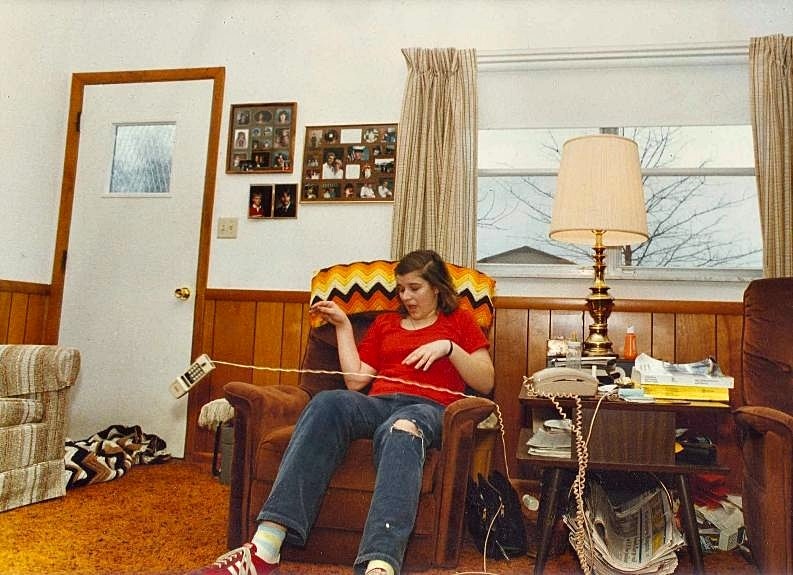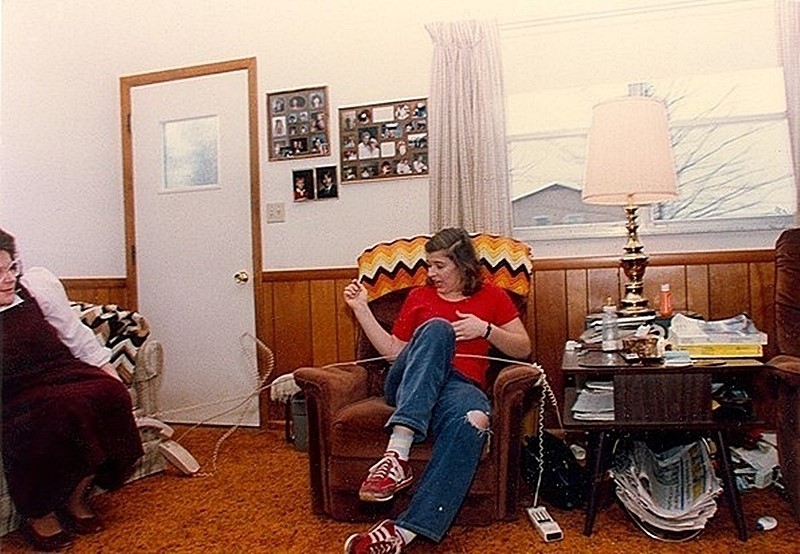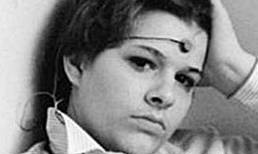Tina Resch (married name Christina Boyer) is an American woman who as a teen was at the focus of poltergeist-type phenomena at her home in Columbus, Ohio, in 1984. The episode generated international publicity and controversy. Resch was later sentenced to life imprisonment for the killing of her young child, a crime it would appear she likely did not commit, and is still imprisoned.
Contents
Background
Tina Resch was born on 23 October 1969. At ten months she was abandoned in a hospital emergency room; all attempts to trace her mother having failed, she was adopted two years later by John and Joan Resch, Columbus residents who had raised many foster children.
The Resches were strict disciplinarians, using corporal punishment to control the children in their care. Tina was said by Joan to be particularly unruly, considered different from other children from an early age. She was humiliated by teachers and children at four separate schools, finally being withdrawn at fourth grade, although she excelled at scouting and got on well at church. At home Tina felt ignored, and when a young woman who she regarded as her best friend and confidante was killed in a car accident, she felt entirely abandoned. She became desperate to find her birth mother, fantasizing a loving reunion; however, her adoptive parents refused to reveal her birth certificate.
Phenomena
Accounts of the episode were recorded by William Roll, a parapsychologist, based on interviews with the Resch family and with Mike Harden, a local journalist who was involved in the case at an early stage.1All information in this article is drawn from the resulting book (Roll & Storey, 2004) except where otherwise noted. Anomalous disturbances began on 1 March 1984 following an argument between Tina and Joan. Joan had asked her husband to deliver corporal punishment, but for once Tina refused to submit, eventually trying to defend herself with a kitchen knife. In bed later, Tina noticed the numbers on her digital clock radio were racing. The radio started blaring music, and when she tried to stop it kept turning itself back on, until she unplugged it.
The next day, Joan was preparing dinner when a heart monitor attached to an invalid infant sounded for no reason, and persisted, as did its replacement after a visit by a serviceman. That night Joan briefly saw a dark shadow in the living room. The next morning the television set and living room light inexplicably turned off and on. The clothes dryer door slammed shut and the machine turned on repeatedly.
Joan believed that Tina was playing games and insisted she stay where she could see her. Both now heard the dryer turn on, followed by the kitchen garbage disposal unit. Next, every faucet in the house was opened. Joan gathered the family in the family room, where the wall clock’s minute hand was seen to be spinning. John called out a utility engineer to check the power connections, but the disturbances continued. Electrical items even ran when unplugged, and an electrician witnessed light switches apparently moving themselves: tape that was fastened over them disappeared. The Reschs’ son Craig, returning home, witnessed spontaneous movements of furniture and artwork, and also saw a dark shadow.
After yet more disturbances the Resches called the police. One officer drew his gun on seeing a metal pan fly out of a room. Other phenomena witnessed by the family included the movement of two eggs, apparently through the door of a fridge, and sticks of butter creeping over a surface.
John finally accepted that Tina was not to blame, when furniture was violently disturbed while she was at church, although he continued to believe she was somehow responsible for it. As word spread of the disturbances visitors and other family members began to arrive, also a pastor who attempted a ritual blessing. A Mormon exorcism failed. Flying objects began to strike Tina; a table pinned her to the floor and a kitchen knife was flung at her. Tina noticed headaches and stomach-aches whose timing seemed to relate to the phenomena. Joan now had the three youngest foster children placed in other homes temporarily.
Media Reaction
Four days after the onset of the disturbances, John Resch asked a family friend, reporter Mike Harden, if he knew of an expert who could help. Having observed the phenomena himself, Harden asked photographer Fred Shannon to try to capture them on film. This proved difficult, as although Shannon also witnessed the phenomena nothing happened when he aimed a camera at it. Eventually, by aiming the camera surreptitiously and pretending his attention was elsewhere, he captured two shots of a phone apparently flying through the air.


Harden’s story and Shannon’s two pictures were published in the Columbus Dispatch on 6 March. They were republished by papers around the country and internationally. The family stayed in a motel for three days, but the disturbances recommenced the moment they returned home, which was now being repeatedly visited by reporters and television crews. On 8 March, the family held a press conference for forty media representatives. However, there was no phenomena for them to observe. After eight hours, Joan said to Tina, ‘Something has got to happen’. Drew Hadwal of WTVN-TV in Columbus had inadvertently left his camera rolling and it tumbled to the floor; when he watched the footage later it showed Tina, having ascertained that no one was watching her, yank the lamp to the floor. For the media this changed the story to a case of fraud.
Investigation
Harden sought expert help from Duke University’s parapsychology laboratory, which put him in touch with William Roll, then director of the Psychical Research Foundation. Roll was an experienced investigator of poltergeist-type phenomena, for which he had coined the term ‘recurring spontaneous psychokinesis’ (RSPK), indicating that the person at the centre of the disturbance was the unconscious cause of it (as opposed to a ‘noisy ghost’ or spirit). He suggested that Tina be examined by a neurologist and also agreed to visit the house with an assistant trained in clinical psychology, Kelly Powers. The pair arrived on 11 March, and Roll began taking statements from numerous witnesses. Phenomena initially observed by Roll had a possible normal explanation, generally an action on Tina’s part, although she herself apparently believed the objects were moving unaided. For her part, Powers witnessed occurrences for which Tina could not have been responsible.
On 13 March Roll and Powers briefly left the house and on their return learned that the phenomena had returned with a vengeance. Roll arranged to take Tina for testing at parapsychological centres in North Carolina, and while making the arrangements he witnessed the screeching sound emitted by the Resch’s telephone that had become typical since the phenomena had started. The next day Roll witnessed motion by an object (a teacup) while neither Tina nor anyone else was close enough to move it. In 52 minutes, he recorded fifteen movements of objects and five unexplained sounds. Six objects had moved while Roll had been watching Tina and was certain she was not responsible;he had handled three of the objects beforehand, checking for trick devices.
Testing
Roll had tested Tina for psychokinetic ability, observing that she rolled doubles at a rate well above chance. However, in a formal test carried out by Richard Broughton at the Institute for Parapsychology on 29 March, she scored no better than chance. She then broke her leg in an accident and had to be taken home.
In a second set of tests in October, Tina was first hypnotized, and objects were observed to take flight: one travelled about forty feet, and others rounded corners. Three factors were found to suppress the incidents: Tina being asleep, deliberate attempts to stimulate psychokinesis, and video cameras recording. Psychological testing revealed signs of a neglected and abusive past, and emotional reactions typical of a much younger child, but no actual psychosis.Further psychokinesis testing in July 1985 was negative.
Roll’s Interpretation
Neurological tests revealed a brain stem anomaly and resulted in a diagnosis of Tourette’s syndrome, which Roll hypothesized manifested psychically as RSPK. Following research by Michael Persinger, Roll also linked the disturbances to a magnetic storm that had swept through the Earth’s atmosphere during 1-3 March 1984. Based on research by Hal Puthoff and William Joines, he further speculated that RSPK is powered by zero-point energy, in this case harnessed by Tina’s subconscious mind.2Roll & Storey (2004), 219-24.
Criticism and Controversy
National media coverage brought the case to the attention of the newly-formed Committee for Scientific Investigation of Claims of the Paranormal (CSICOP). Stage magician James Randi, a prominent sceptic, was tasked with investigating the case and arrived at the Resch residence on 13 March, accompanied by two other investigators, as well as reporters and television crews. He offered $10,000 to the family if they could show him spontaneous phenomena he considered genuine. Joan Resch welcomed two other investigators but refused to let Randi enter.3Harden (1984).
In August Randi was invited to a Parapsychology Association conference, where he made a presentation focused on critiques of Fred Shannon’s photos; a subsequent article in Skeptical Inquirer attributed the phenomena entirely to trickery on the part of an attention-seeking teen, claiming that the images showedthat Tina herself might have thrown the telephone. He drew attention to the video footage that showed her pulling over a lamp, and cited testimony from reporters who having seen nothing were unimpressed. He also criticized Roll’s observational methodology.4Randi (1985).
In his book, Roll complains that Randi ignored testimony from family members, friends, associates and investigators who had witnessed incidents, and that he misrepresented Roll’s written reports, for instance saying that Tina was alone during one spell of phenomena when Roll had actually written that he had been with her during that time. Roll also objected to Randi saying he (Roll) had claimed to see a tape recorder behind him move, when he had made no such claim. In a drawn map representing part of the home Randi omitted relevant items of furniture and altered facts to suit his arguments: a couch which moved by itself, and which Randi claimed, being on wheels, could ‘easily’ have been pulled out by Tina using her foot, was in fact on fixed legs.
Roll notes that Randi failed to obtain corroboration from three witnesses who had been present during the telephone episode caught in Shannon’s photos (Shannon, Mike Harden and Tina’s older brother Craig). He further points out that Tina was right-handed, casting doubt on Randi’s construction that she threw the phone with her left hand.
Later Life
Tina attempted suicide at the age of fifteen and soon afterwards fled the Resch house, where she apparently had been sexually abused by an older brother. She married aged sixteen to an abusive and controlling man, escaping a year later. She became pregnant during a second relationship and bore a daughter, Amber, on 29 September 1988.
On 14 April1992, three-year-old Amber died while in the care of Tina’s boyfriend, David Herrin. At the time, Tina was visiting with a counselor she had befriended during the testing. Despite her solid alibi she was charged with murder and held in jail for two and a half years before trial. Her lawyer advised her to choose an ‘Alford plea,’ which in the law of the state of Georgia, where Tina now lived, allowed a defendant to accept punishment without admitting guilt.5Conrad (2006, 2019). This source includes extensive excerpts from hearing transcripts. The lawyer opined she would otherwise be convicted and sentenced to death, even though a lie-detector test showed that she was maintaining her innocence truthfully.
Tina accepted this option. The case having received abundant media publicity, Tina may well have been convicted in the court of public opinion, especially as the sheriff and the prosecutor used her case to further their own re-election prospects.6Horn (2008). She remains imprisoned to this day, despite the efforts of supporters.7Conrad (2006, 2019); see ‘News section — The Christina Boyer Legal Case’. See also Banning (n.d.). For updates, see here.
KM Wehrstein
Literature
Banning, J. (n.d.). Christina Boyer: How a Dutch photographer fights for an American woman, wrongly imprisoned for murdering her own child. [Web page.]
Conrad, J. (2006, 2019). News section – The Christina Boyer legal case. [Web page.]
Harden, M. (1984). Visiting magician told to disappear. Columbus Dispatch (14 March). Reproduced here (scroll almost to bottom of page).
Horn, S. (2008). The real story of Christina Resch Boyer: Did a ‘perfect storm’ of events lead to life imprisonment? StarNews Online (January 20). [Web page.]
Randi, J. (1984–85). The Columbus poltergeist case: Part I. Skeptical Inquirer 9, 221–35.
Roll, W., & Storey, V. (2004). Unleashed – Of Poltergeists & Murder: The Curious Story of Tina Resch. New York: Paraview Pocket Books.



